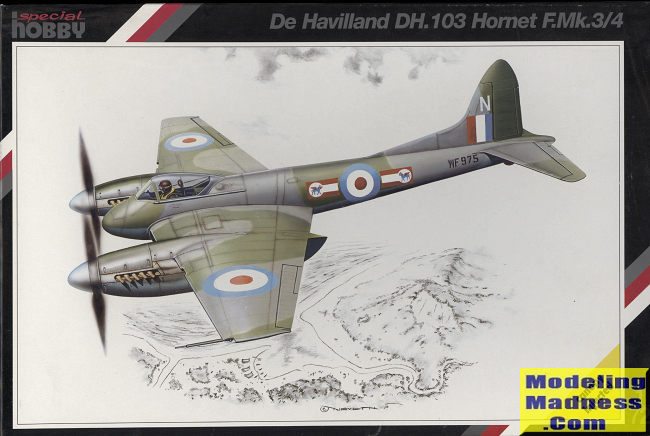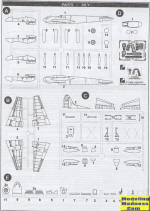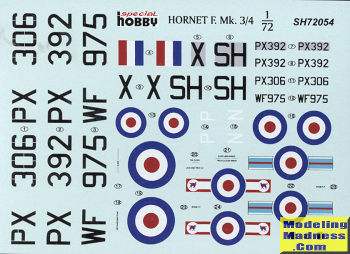
| KIT #: | SH 72054 |
| PRICE: | $27.93 shipped |
| DECALS: | Three options |
| REVIEWER: | Scott Van Aken |
| NOTES: | Short run with photo etch and resin parts |

| HISTORY |
In early 1941, Geoffrey deHavilland was asked to develop a long range fighter based on his Mosquito to use in the Far East. Though it was originally a private venture, it was assigned specification F.12/43 once a wooden mockup was examined in early 1943. The Merlin was chosen to power this aircraft due to its slim lines and proven reliability. Though a smaller airframe than the Mosquito, it was similar in construction, using mostly wood laminates. First flight was in July of 1943 with Sir Geoffrey at the controls, as he often did with company prototypes.
All who flew the prototype through its various tests were impressed with the speed and handling of the aircraft. The first production plane was delivered in January of 1945, but the aircraft was too late to take part in any actions during WWII. The first squadron to equip with the new aircraft was 64 Squadron and it did participate in the victory flyover in June of 1946. Next units to equip with the new plane were 19, 41, and 65 Squadrons.
By 1950, the Hornet F.1 had been declared obsolete but the later F.3 was used in Malaya and Singapore as a ground attack aircraft. The F.4 version had room in the lower fuselage for cameras and was used for tactical recon. The plane was fully withdrawn from RAF service by 1956 and all examples were scrapped. There are none left for museums and thanks to its wooden construction, the odds of finding one in the jungles of Malaysia that could be restored to flying condition are extremely remote.
| THE KIT |
 Special
Hobby produced a full series of Hornet/Sea Hornet kits and most of us
grabbed at least one of the variants. This one was offered on sale and
though I have built the Frog kit a few times, felt another Hornet never
hurt. Besides, it is one of the more appealing looking twin engine aircraft
ever developed.
Special
Hobby produced a full series of Hornet/Sea Hornet kits and most of us
grabbed at least one of the variants. This one was offered on sale and
though I have built the Frog kit a few times, felt another Hornet never
hurt. Besides, it is one of the more appealing looking twin engine aircraft
ever developed.
Not surprisingly, most of the parts in this
kit are the same as in the F.1 boxing. The clear sprue even includes the
radar operator's canopy from the Sea Hornet NF as well as the tail hook and
a few other bits not required. The
 main
difference in this one from the F.1 is the larger fin/rudder. To recap,
this is a full blown multi-media kit with photo etch
for some of the interior bits like instrument panel and seat harness as well
as for the landing gear oleo scissors. Resin is used for the tail wheel
well, wheels, exhaust, instrument panel backing, tail wheel, seat. forward
lower gun section, and a few other things. Like the plastic sprues, there
are bits only used for other variants that can be consigned to the spares
bit.
main
difference in this one from the F.1 is the larger fin/rudder. To recap,
this is a full blown multi-media kit with photo etch
for some of the interior bits like instrument panel and seat harness as well
as for the landing gear oleo scissors. Resin is used for the tail wheel
well, wheels, exhaust, instrument panel backing, tail wheel, seat. forward
lower gun section, and a few other things. Like the plastic sprues, there
are bits only used for other variants that can be consigned to the spares
bit.
The plastic parts are very well done, as one would expect from a modern MPM kit. A nice touch is that the canopy is injected plastic vice the usual vacuformed one used in years prior to the production of this kit. There are really no options unless you want to leave off the bomb and rocket racks on the underside. Depending on the decal scheme you are going to use, you may want to consider leaving these off until after decaling. No rockets or bombs are included. You also have to scratch build a pitot tube. This kit also has the dreaded single prop blades and one has to be quite careful when assembling the props as they each turn in a different direction.
Instructions are very good with color
references provided throughout the construction sequences. References are in
generic names other than the overall color sch eme
which also provides Humbrol paint numbers. There are three
markings options. The box art plane is in dark sea grey/dark green over
light grey and is with 45 Squadron in Malaya during 1955. This is the F.4
variant so you need to add the camera windows. In the same scheme and at the
same time and place is an F.3 from 33 Squadron. The third options if from
1948 and is with 64 squadron. This is the training unit so the overall
silver painted plane has a yellow rear fuselage and fin with yellow
spinners. The decal sheet includes codes and serials with a silver-grey
background in case you do not wish to mask these areas off. Decals are
nicely printed as always and should work just fine.
eme
which also provides Humbrol paint numbers. There are three
markings options. The box art plane is in dark sea grey/dark green over
light grey and is with 45 Squadron in Malaya during 1955. This is the F.4
variant so you need to add the camera windows. In the same scheme and at the
same time and place is an F.3 from 33 Squadron. The third options if from
1948 and is with 64 squadron. This is the training unit so the overall
silver painted plane has a yellow rear fuselage and fin with yellow
spinners. The decal sheet includes codes and serials with a silver-grey
background in case you do not wish to mask these areas off. Decals are
nicely printed as always and should work just fine.
| CONCLUSIONS |
While this is not a hugely popular aircraft, it is one of the prettiest around. SH kits take a bit of effort to build, but anyone past the beginner stage should be able to handle it without issues.
July 2018
Copyright ModelingMadness.com. All rights reserved.
Thanks to me for picking this one up when it was on sale.
If you would like your product reviewed fairly and quickly, please contact the editor or see other details in the Note to Contributors.